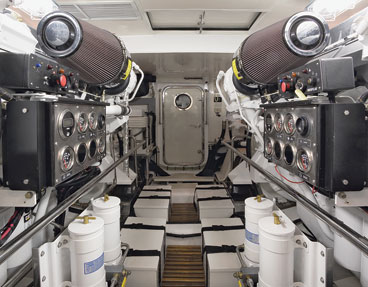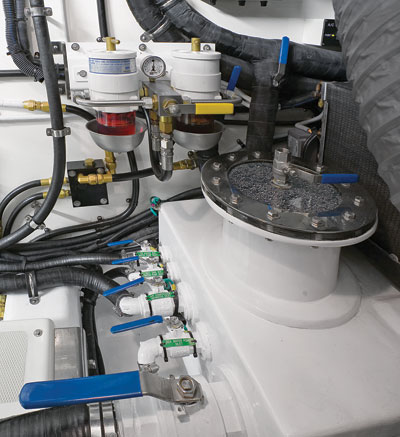
Engine Stress
When I began my career as a captain, attitudes were pretty lax about prophylactic diesel engine maintenance. It wasn’t that we didn’t care. We devotedly changed oil, fuel filters, zincs and seawater impellers, but anything beyond was delayed until the engines showed symptoms. But back then, 20 knots was blazing speed, and a bit of diesel smoke was part of the allure of the sea. Symptoms came on gradually too. A little extra smoke or slightly elevated temperatures necessitated an injector change or heat exchanger cleaning, when convenient.
Since then horsepower has tripled within a given-size engine. Fuel economy is up while exhaust emissions are way, way down. But this stresses an engine’s components to the maximum. What could wait in years past can now ruin an engine in hours, minutes or even seconds. Preventive maintenance and careful attention to fuel are the keys to long life from today’s engines.
“The attitude used to be ‘If it isn’t broken, don’t fix it,'” says Charlie Schloemer, president of Palm Beach Power in West Palm Beach, Florida. This carried through the ’80s as the quest for improved horsepower-to-weight took hold, but back then captains joked that some engines broke down so often they should be held together with zippers, not bolts, to speed repairs.
Today, manufacturing methods and materials, computer simulations, sophisticated monitoring and decades of experience help manufacturers keep engines trouble free. They also bring a much better understanding of wear. “Manufacturers determine maintenance schedules based on thousands of hours of experience with those engines,” Schloemer says. On MTU diesels that Schloemer works on, he says, “exhaust valves need to be adjusted every 500 hours. They do wear.” Those valves are worn not by engine hours, but by how much burned fuel passes through them, exemplifying changing maintenance needs as horsepower increases.
Fuel delivery has changed the most. “It’s tighter tolerances within the fuel system that allows us to have more precise control over timing of the injection, the quantity of fuel and higher pressures that result in better fuel atomization,” says Dan Burns, an engineering manager with Cummins MerCruiser Diesel. But tight clearances won’t tolerate contamination. “A 50-micron particle might flow right through, but get a 10-micron particle in the wrong spot and you bring an injector to a stop,” Burns says.
Thirty-micron primary filters and 10-micron secondaries, common a decade ago, have been replaced by 10- and 2-micron filters — for particles smaller than red blood cells and many bacteria. Change these filters regularly, Burns says, but more important is a quick daily inspection of fuel filter bowls (image below). “We’ve built in alarms, but there is no comparison to checking yourself,” he says. Clean fuel is “clear and bright,” not hazy, and either golden or dyed red for tax reasons. Just a bit of contamination in the filter bowl is normal, but anything more is an expensive gamble, because injectors can now exceed $1,000 each.

The reverse is also true. “If properly maintained, I expect a common-rail fuel system to last the life of the engine,” Burns says. Some engines even calculate and compensate for wear of injector nozzles, extending their service life. Limitless control over fuel delivery allows multiple, tiny early and late injections to clean exhausts and mitigate internal engine stress.
Even on these sophisticated diesels, only about 40 percent of their fuel goes toward turning propellers. The rest is wasted as heat, which means substantially more stress on cooling systems as horsepower increases. To save space and weight inside boats, those cooling systems haven’t increased in volume, either. They transfer more heat overboard with thinner-wall heat-exchanger tubes, more seawater flowing through the system and more components cooled directly with seawater, not engine coolant — all are harder on internal components.
“You really need to follow engine manufacturers’ maintenance guidelines for both engine hours and time intervals,” Schloemer warns. Waiting longer may add many thousands of dollars to replace ruined cooling system parts. If parts corrode through, multiply that exponentially.
Engineers lower stress on cooling systems where they can. MAN, for example, has changed its water-cooled exhaust manifolds to decrease the amount of exhaust heat transferred to the cooling system (read more about MAN here). This change also allows more powerful turbochargers, but it greatly increases the degree of heat those turbos experience.
Charge-air cooling — taking 300-degree air from turbos down to a manageable 120 degrees or so with intercoolers — today typically employs seawater. This increases horsepower but also corrosion and fouling, necessitating regular service. On engines where charge air is cooled with engine coolant, not seawater, additional heat breaks down the antifreeze intended to lubricate and protect engine parts.
Engine oil also experiences more stress as horsepower increases. “We take a lot of heat out of the pistons with the oil,” Burns says. Spraying oil onto the underside of the pistons increases temperatures within the oil pan, breaking down oil over time. “Modern engines are driving improvements in oil quality,” Burns says. Still, oil, filters and oil coolers are increasingly important.
Technology has also added one huge advantage — that is sophisticated engine monitoring. Intake manifold temperature, for example, will skyrocket immediately if seawater flow stops — minutes before the engine overheats. That same sensor will also warn of fouled charge-air coolers. Fuel system sensors monitor for clogged filters or water intrusion. Engines even monitor batteries — once only for starting, but now critical to engine operation.
Instead of the bells and lights of old engine alarms, computers now reduce the throttle automatically for self-preservation. But this warns of impending failure, not needed maintenance. On MAN engines, for instance, normal charge-air temperature is around 120 degrees, but the alarm won’t trigger until 158 degrees. Putting off maintenance stresses components over many engine hours.
Preventive maintenance has certainly become expensive on today’s high-horsepower diesel engines, but these engines also break down less often, which means safer and more enjoyable boating. Add to that better fuel economy at greater cruising speeds and cleaner exhausts. Instead of yesteryear’s “If it ain’t broke, don’t fix it,” a better maxim today might be: Pay now or pay much more later.








